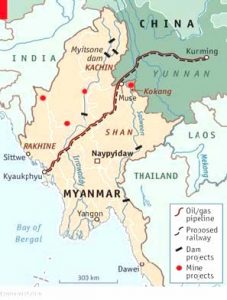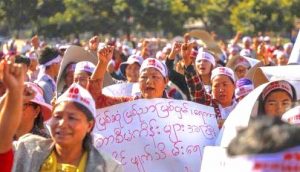
Military Coup in Myanmar
Feb. 16—The masses in Myanmar (Burma) are defiantly protesting the Feb. 1st military coup that overthrew Aung San Suu Kyi’s civilian government.
Demonstrations in cities across the country have swelled to hundreds of thousands. Young workers are in the lead. Doctors, nurses, and other government workers have walked off their jobs. They call on masses to “tear down the military dictatorship.”
That will take a lot more than “restoring the democratically elected government” (as US, Indian and other capitalist leaders urge).
The Myanmar military (Tatmadaw) is the face of capitalist dictatorship. It secretly controls much of the economy, including state-owned enterprises and large private “crony companies.”
Capitalism, too, must be torn down. That means communist revolution. It means a break with the anti-communist “pro-democracy” movement.
Suu Kyi’s “democracy” was never anything but a front for the Tatmadaw. The 2008 Myanmar constitution guarantees the military 25% of the seats in the legislature, control over key ministries, and veto power over constitutional amendments.
Suu Kyi has been complicit in the military’s genocidal attacks on the Rohingya Muslim minority. Those who rally around her are seriously misled, or worse. So are followers of Buddhist monks who promote violent Buddhist nationalism that justifies anti-Muslim attacks.
Is China Behind the Tatmadaw?
Probably not. China, bordering Myanmar, is its largest trading partner. Relations between the two state-capitalist countries grew closer after the 2017 Rohingya migrant crisis, when Western capitalists imposed sanctions. Myanmar is strategically key to China’s plans to control the Indian Ocean – and also to India’s plans to do the same.
But in the last year, Beijing has built stronger ties to Suu Kyi’s civilian government than it had with the military regime. The Chinese rulers want stability in Myanmar, not upheaval. They see pro-democracy protests as dangerously like those in Hong Kong.
The coup has sharpened the US-China conflict. The US, with little to lose in Myanmar, quickly condemned the coup, praised protesters and blamed China. For decades, the Western human rights movement idolized Suu Kyi (imprisoned or under house arrest). Now that she’s under attack again, it’s easier for them to overlook her complicity in the Rohingya genocide.
Communism in Myanmar: Learn from the Past, Build for the Future
Communism in Burma, its strengths, weaknesses and errors, reflected those of the 20th-century international communist movement. These include:
Nationalism – error. The Burmese Communist Party, founded in 1939, arose from the liberation struggle against British imperialism. Aung San (father of Suu Kyi) was its first secretary-general. It was more nationalist than Marxist. Aung San and other leaders even supported Japanese fascism (Britain’s enemy).
United Front Against Fascism – error. Unlike Aung San, communists organized mass resistance to the Japanese invasion during World War II but submerged the class struggle. Afterward, they again mobilized strikes and protests of workers and farmers against British imperialism. But they remained part of Aung San’s broad alliance.
Armed Class Struggle – strength. Burmese communists soon rejected Aung San’s strategy of peaceful negotiations. Against Soviet advice, they organized violent class struggle against Burmese as well as British capitalists.
Don’t Settle for Reforms – strength. The rulers’ fear of the growing communist insurgency led Britain to grant Burmese independence in 1947. The new western-style government was led by socialists and nationalists. They introduced new trade unions and social reforms, trying to undercut the communist base. But Communist and national-minority groups continued to lead growing insurgencies, encouraged by the success of the 1949 Chinese revolution.
Didn’t Make Marxism or Communism a Mass issue – fatal weakness. In 1962, a military coup declared a “socialist state” run by senior military officers, under General Ne Win. It launched a major anti-communist crusade in the name of defending Buddhism (Burma’s majority religion).
Burmese communists were unable to withstand this attack, mainly because they had never fought for communist ideas among the masses. The Chinese government (taking the capitalist road) allied itself with the Burmese military regime.
Unlike most self-identified communist groups today, the International Communist Workers’ Party has learned these lessons, and more. We invite readers in and from Myanmar, and everywhere, to join and organize collectives that are now learning to put them into practice.
The fearlessness of the Burmese masses in motion – like the farmers’ struggle in India – shows that workers have nothing to lose but their chains. We have a world to win – by mobilizing masses for communism.

Protest against China-sponsored Myitsone Dam in northern Myanmar

